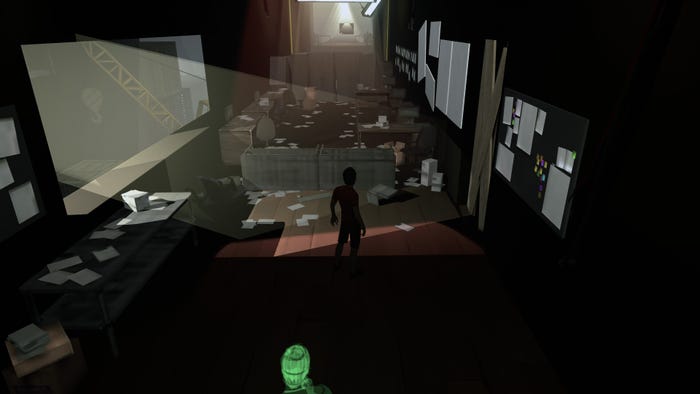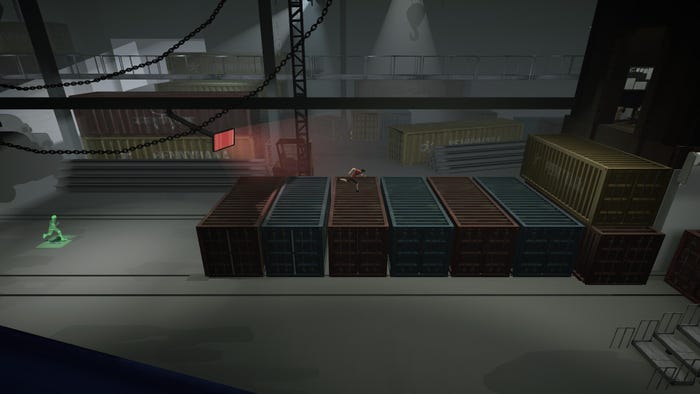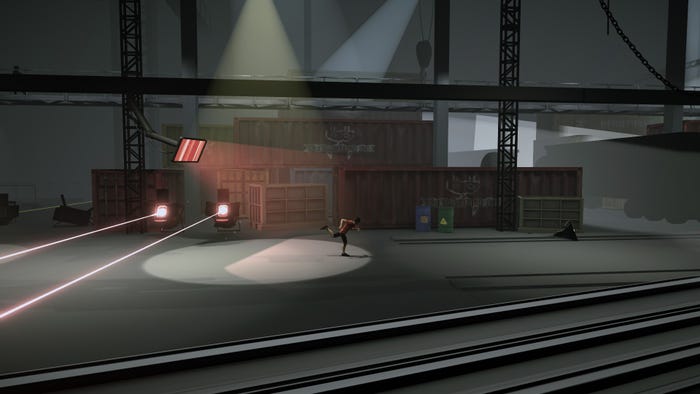Trending
Opinion: How will Project 2025 impact game developers?
The Heritage Foundation's manifesto for the possible next administration could do great harm to many, including large portions of the game development community.

TRY AGAIN developer Adam Morina talks about how their own frustrations coming up with a game concept would lead to a game about those very frustrations.

The IGF (Independent Games Festival) aims to encourage innovation in game development and to recognize independent game developers advancing the medium. Every year, Game Developer sits down with the finalists for the IGF ahead of GDC to explore the themes, design decisions, and tools behind each entry. Game Developer and GDC are sibling organizations under Informa Tech.
TRY AGAIN sees players guiding a character through an ever-changing game world, dealing with the constant changes of a developer crunching to get the game finished on time.
Adam Morina, the director of this Best Student Game-nominated title, spoke with Game Developer about how the concept of a game about being frustrated with game design came about from those exact frustrations, the way the interplay between the in-game player and the in-game designer’s clashes helped shape compelling story and gameplay, and how it can be far more important to get something finished and out the door than to “perfect” it into eternity.
Who are you, and what was your role in developing TRY AGAIN?
My name is Adam Morina and I'm the game director for TRY AGAIN!
What's your background in making games?
My entry into making games was through Graduate school. I have a narrative/film background, working as a writer and producer, but I was always passionate about and determined to break into games. I'd prototype and build little (terrible) Unreal/Unity prototypes. Thankfully, I was accepted into the USC Games Master’s program and went from there.
I think what’s really cool about our team is everyone came from a wide variety of diverse backgrounds. There are so many different programs within USC, and for the graduates amongst the team, everyone had unique jobs before coming back to school. The entire team wore multiple hats throughout development. We all just had a shared passion for games and loved hanging out together. We worked in-person almost every day and it helped so much.

Images via the Rejects
How did you come up with the concept for TRY AGAIN?
TRY AGAIN was created out of pure frustration. Our thesis professors for the Master's program, Laird Malamed and Martzi Campos (both amazing teachers and mentors) were looking for our deliverables for thesis pitching. I had built a VR game the year before with my insanely talented friend, Ingram Mao, so I was prototyping everything in VR. I built around 8 or 9 prototypes that all had no real direction. Laird asked us to write a 5-minute script as an exercise for a thesis concept. I wrote two, the first was this weird VR detective game. The second was a top-down shooter about a guy stuck in a game arguing with the designer of the game. That was the original idea for TRY AGAIN — just pure annoyance with the process of trying to come up with an idea.
I ended up prototyping TRY AGAIN as a platformer influenced by games like INSIDE and Crash Bandicoot (which I had been playing a lot of). Through the early development it found the basic form of what you see now. [I] pitched it for the Advanced Games Project at USC; it got accepted and I then built a team of dedicated students and we worked insanely hard for 10 months to deliver it. We had a strong faculty team behind us and I’m so grateful to Andy Nealen, Jim Huntley, Richard Lemarchand, Lesley Matheson, and Scott Easley, all of whom provided great insight to completing a successful game. I also must give a huge shout out to our two industry advisors Aaron Martin (Rockstar Games) and Anoop Shekar (Santa Monica Studios). Their guidance helped shape and build the foundation of this game.
What development tools were used to build your game?
We built this game using base Unity. We also used other awesome tools as well like Rayfire, which our Tech Art Lead Timothy Lim modified to create all the destruction in game.
Since we had no budget, we took a very DIY approach to the development of our game. A few of us built a mini-mocap studio using multiple iPhones that we ran through AI animation trainers. We blended those with keyframe animations to get all the animations you see in the gameplay and cutscenes.
TRY AGAIN explores the uncertainties of game development from within a released game. What thoughts went into working the act of game creation into a game for players to experience?
It starts with the relationship between Benny and The Designer. That is the core of TRY AGAIN, and really the clearest way we define the act of game creation into the game. Our team is incredible, and ideas came from everyone. Because I had a simple vision and goal, our team was able to take that bit of vision and expand on it.
The biggest factor in this process is having the characters respond to what the player does. If the player is running and stops, comment on it. If the player is crushed by a shipping container, create banter between The Designer and Benny. Because the game has just two characters, it gave us room to define their relationship. Benny has a clear goal and so does The Designer. As long as we defined those motivations clearly and early, the player felt an immediate connection to Benny. Who hasn’t dreamed about escaping from a boring job? We wanted the player to be represented through Benny.

Images via the Rejects.
While being about game development, there is an excellent platformer experience to be had as well. What thoughts went into designing platforming challenges that would keep the player moving and thinking at high speeds?
Thank you! That's awesome to hear because we really wanted the game to be fun and gameplay-driven while still delivering a rich, character-driven story. We all like fun games that require response time and feel good on the sticks. From a gameplay perspective, our lead designer Dexter Knaack and lead engineer Jason Chen helped us create levels that would define and change in conjunction with the narrative design. Our narrative lead, Jake Wylykanowitz worked very closely with design. Marrying level and narrative design helps create the illusion that The Designer is fixing this game in real time.
Our first and most important pillar was a fast pace. We built sections/levels through development that were really strong but slowed the game down too much. We looked at endless runners a lot and tried to create that experience but if the player wanted, they could stop. When they stopped, the narrative would react to it. The worse you do, the more The Designer is happy, the better you do the more annoyed she is with Benny.
What thoughts went into creating the shifting game world? How did you create these to reflect the feelings of the "insecure designer" shaping the experience?
Early on in development and in the original prototypes, we used a reverse time mechanic that would rewind Benny and all the destruction. It was visually cool, but we couldn't figure out how it fit into the story and ultimately cut it.
I have to give enormous credit to USC Games Chair Danny Bilson who suggested upping the stakes for the Designer. By putting her under a time crunch from her publisher to finish this game she’s been working on for years, it instantly created more conflict for the characters. Because we were looking at everything through this narrative framework, we wanted the gameplay to be motivated by the characters’ intentions. I think all of us (especially me) at some point in game development feel a sense of insecurity, so it was easy to look at our own experiences as defining traits for The Designer. We wanted a gameplay hook that felt different than just standard platforming. Because the game is supposed to be in 'development', and you can't trust The Designer, that should be reflected in the gameplay/level design.
A section we worked on forever is the exploding boiler room. That section is clearly exemplified by our own development. The Designer is frustrated with her work and destroys that part of the level, which is representative of how we felt piecing it together repeatedly during development. We tried different camera angles and destruction patterns, but ultimately it was about visual clarity and showing the high wire act of their relationship. We knew that if things changed and happened as they were shifting in the narrative, it could create this real time insecurity of an antagonist both in gameplay and narrative.
How did you design Benny, our test character who wants to be a main character? What ideas went into how they would look and sound?
Funny enough, Benny is very, very similar to how he was conceived from the very beginning. Andy Nealen, our AGP advisor, worked closely with us on the design and character controller for Benny. The biggest shift was making Benny a bit of an antagonist on his own and pulling him away from being just a test dummy. In the original prototypes, he's essentially a crash test dummy, but through development he became a guy with a clear motivation. He's kind of a jackass, and it's not clear who the hero is in the game.
We did a lot of work to get players to empathize with him through subtle IK animations, or the cut scene work. This was really defined by people like our lead gameplay programmer, Shravan Kumar and our AI programmer, Tai Nguyen. His look informed his movement. Our art leads and character artists, Akshata Nagendra, Mi Coz, Eggsy Zhang, Timothy Lim, and Marcus Gordon helped figure out how Benny should look. We were able to take this a lot farther by representing his experience through art and environment. Once Nolan North and Stephanie Kerbis came on board, and brought so much to both characters, the whole game took on new life.
At the suggestion of Nolan, he taught us something that Naughty Dog used in their development of Uncharted called chasing picture. Nolan and Stephanie would do improv sessions over the game as we'd play it. This gave us some unique character moments and helped Benny become a real guy rather than just a test dummy.

Images via the Rejects.
Players are not just expected to play well, but to overcome the systems in the game, in a sense, through "exploiting" the rules. How did you work this play style into the game? How did you design a means of "exploiting" the rules? How do you make players feel like they're being crafty with how they use the rules even though, as the creator, this is what you expect them to do?
That came together through endless playtesting. We had two of the best leads in our QA lead Edwin Leon Du and our usability lead Sasha-Mylan Williams. Sasha tracked everything with hyper detail and was able to give us all the feedback on clarity that we needed to refine the project. Edwin was so instrumental in the project that he was working as a Designer by the end of development. Having QA so involved in the project gave us opportunities to use bugs as an advantage. For example, the subway that chases Benny (which The Designer essentially throws at him) started as a bug. We came up with this idea of intentional bugs. This required a lot of QA for actual bug fixing and usability to make sure play testers didn’t think these were unintentional.
Because we are making decisions that show The Designer’s intention and represent her character emotion through gameplay, the moments are more scripted than they are appearing in their presentation. If we are fortunate enough to develop this further, we want to create a system that adapts to player ability, scale difficulty with different set pieces, and provide unique narrative moments depending on your playstyle. The method of intentional exploitation of the rules was driven by gameplay but we were able to justify it through the character relationship and let the narrative motivate it.
TRY AGAIN crams a great deal of play and thoughtfulness into a brief play time. What drew you to create a short experience to tell your story? How did this length serve your goals for the game?
That really comes from the timeframe of our development. We built this game in 10 months with a full-time student team. As you can see, the team went absolutely wild, and I think what we built goes well beyond the production pipeline we had. This is a testament to our producers Abigail Nakaishi, Adrian Lopez, and Akshata Nagendra. My overall goal was to always leave the player wanting more. That’s the biggest comment we see on Steam and it’s incredibly flattering and satisfying; players want more TRY AGAIN.
From the beginning of production, I stressed to everyone that the game should be quality over quantity. I wanted to have a perfect 5 minutes rather than a slow/boring 30/40 minutes. We settled at around 10-15 in playtime, and even in that short of a game, it was nearly impossible to refine and sharpen to the point we did. We definitely would love to expand this game and finish the story properly because we’re filled with so many cool ideas of where it can go.
As you can see, the way the story wraps up in this version is a bit fast. This game was supposed to emulate what would happen over a 3-hour experience. Imagine this as a short film concept for a feature film. But the length ultimately worked to our benefit because the game doesn't overstay its welcome. We're able to move the player through so many different worlds and experiences while throwing in narrative twists and turns. If this was a 3-hour game, players would probably have to sit in sections like the subway for at least 30 minutes, and that felt boring to us. We wanted the game to be reflective of development which is fast and fraught with twists and turns.
Can you tell us about how your own fears and anxieties shaped this experience? How you felt about putting this game out into the world? Now that you have launched the game, have any of those feelings changed, and how do you feel you will look at game creation going forward?
TRY AGAIN was born out of anxiety, fear, and insecurity with the lack of ideas taking shape for thesis pitching. It came from that feeling any person who makes stuff has which is...is this good enough? Will people hate it? The perfectionist mindset is good, but at some point, you just have to finish and release something.
Aside from our amazing team, I think the reason this game clicked is because we kept the vision consistent with my original pitch, but we were always willing to change and adapt based on what was fun, playtesting well, or a cool idea someone on the team had. Vision needs to be adaptable. I wanted people to know there would be NO bad ideas through development. As a result of that philosophy, every single person on the team has an idea they suggested that made it into this game.
I'm so proud of the release on Steam. Right now, we have over 40K downloads, and it's definitely shifted my thoughts on finishing things and putting them out into the world. At first, we were hesitant to put it on Steam, but a mentor and legendary professor, Tracy Fullerton convinced us to do it. I'm so, so glad she did. To see the response and Overwhelmingly Positive reviews on Steam has been wild. We love the games community and it means so much to us that people want to see the game expanded and love the relationship between Benny and The Designer (and the gameplay)!
I can't speak for the rest of the team on this, but for me it reinforced my belief in what makes the games industry so appealing. Game development thrives on the ability to work collaboratively with a team, and trusting the people you hire to do their jobs. I'm someone who likes to make stuff and hold onto it, but with game development it's only 50% done until someone plays it. We're so thankful to everyone who supports our small game and to IGF for nominating us. It was a labor of love and we're thankful people are playing it at all!
You May Also Like